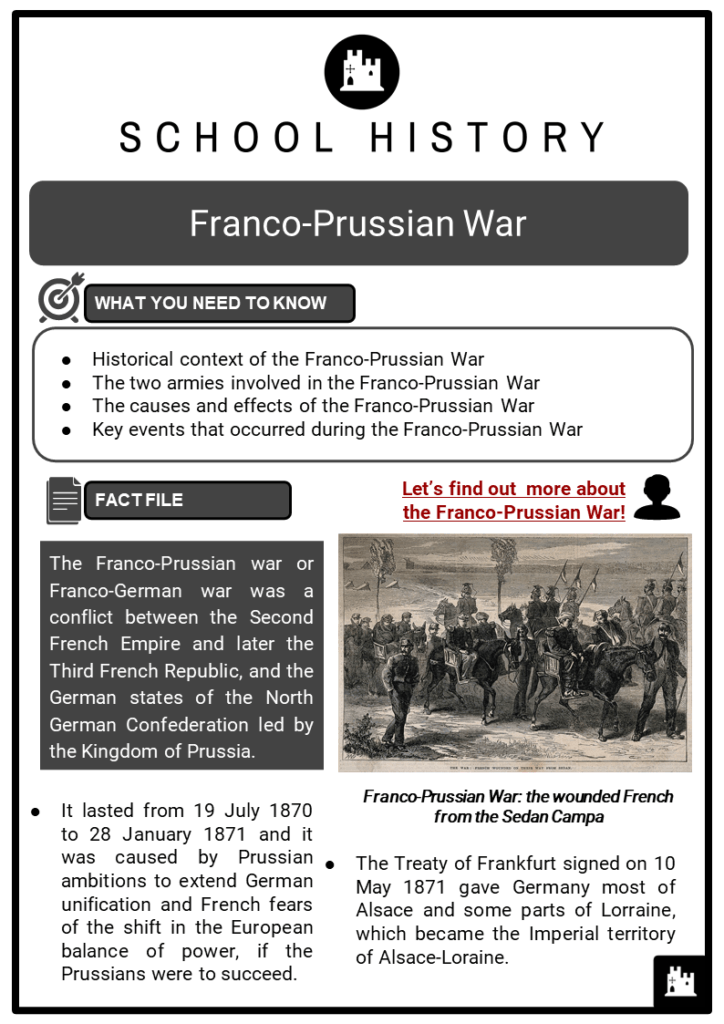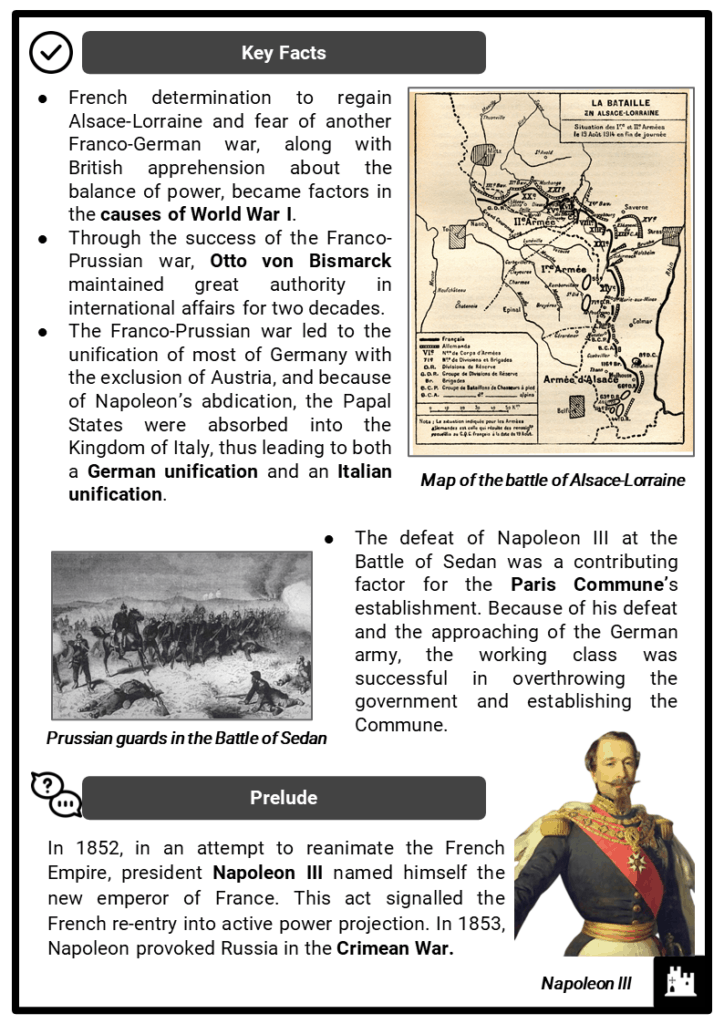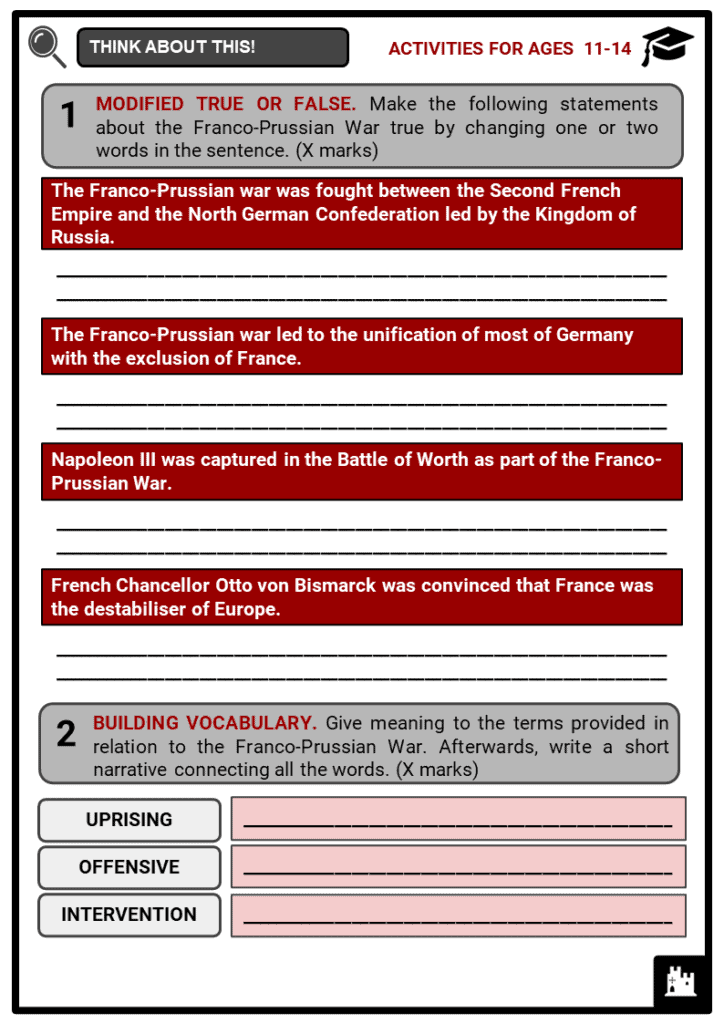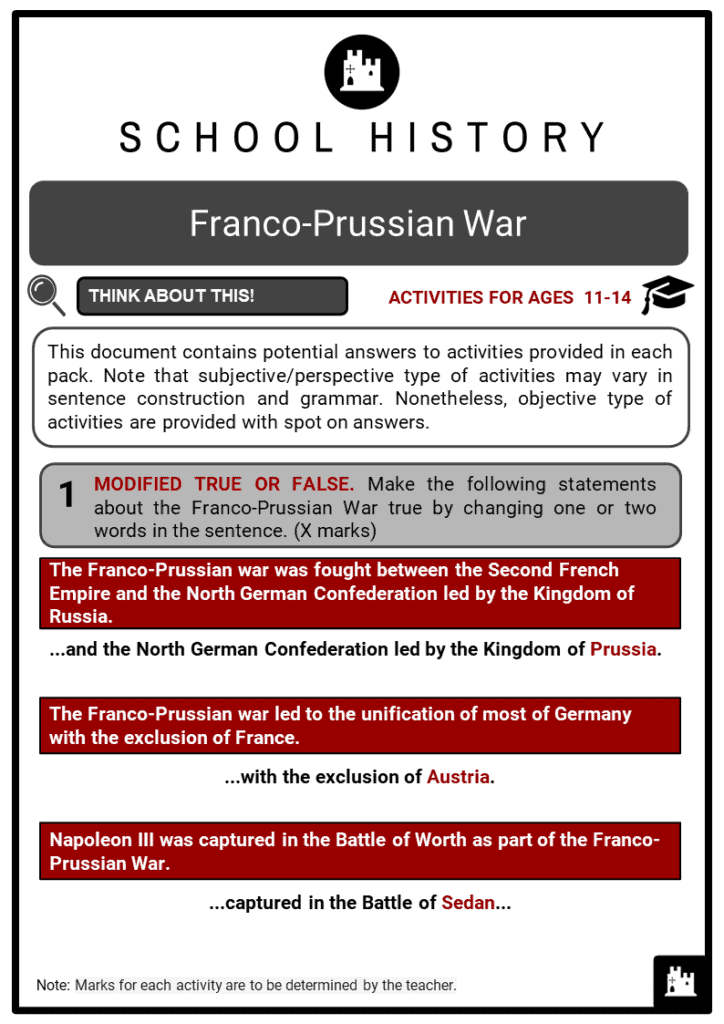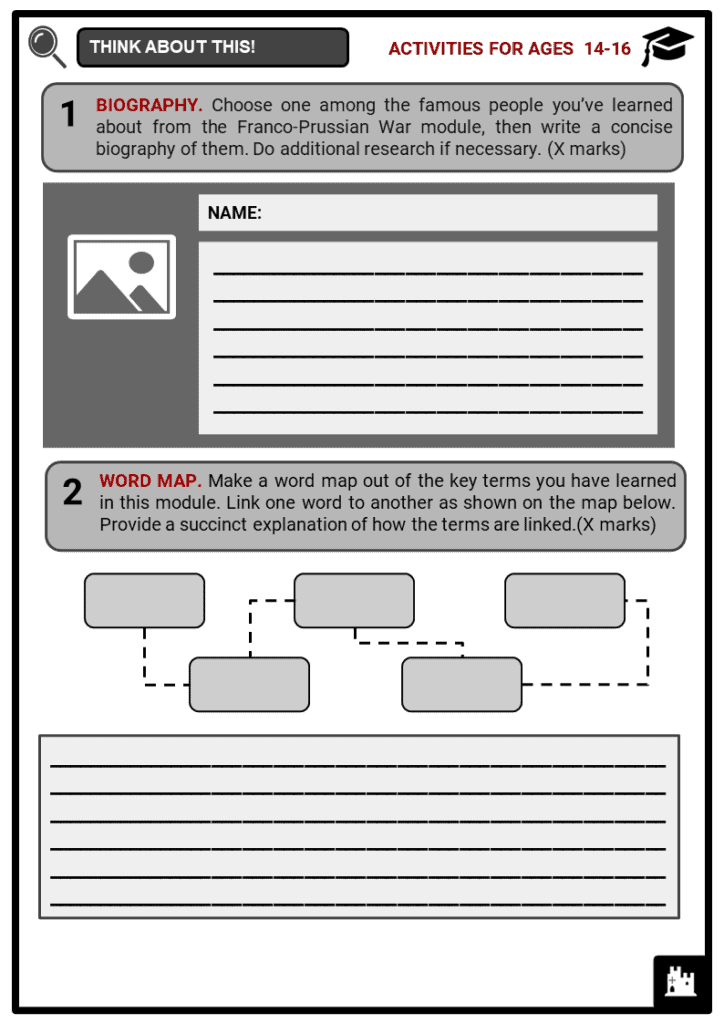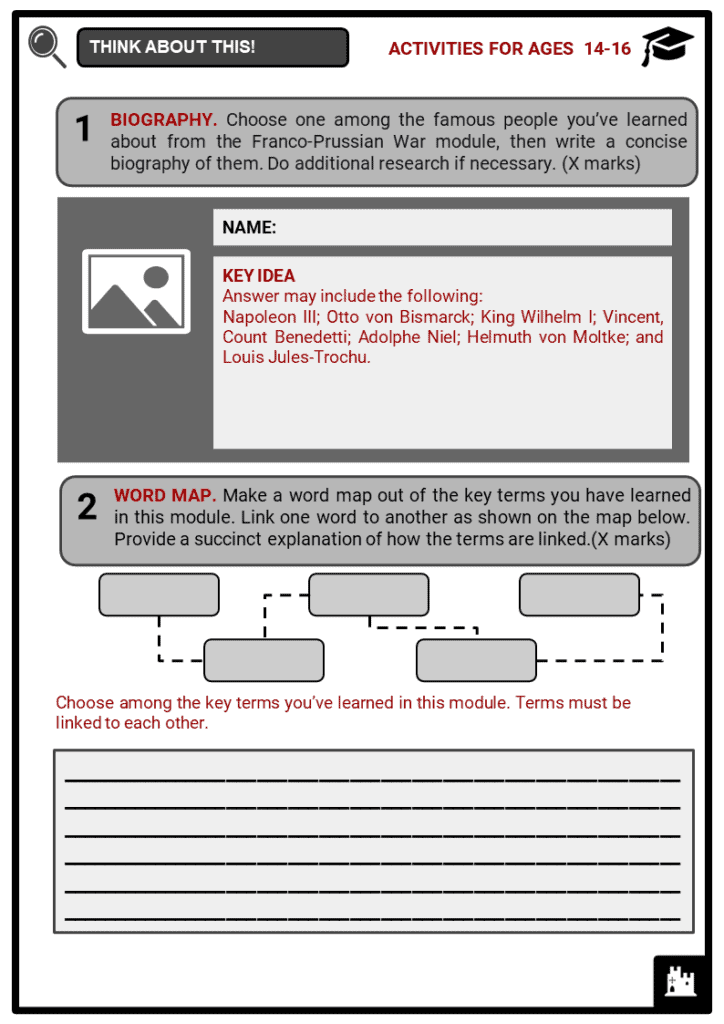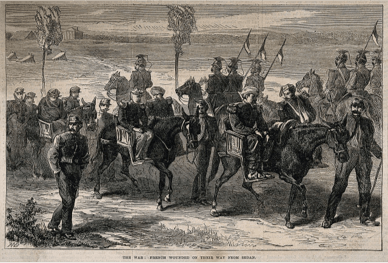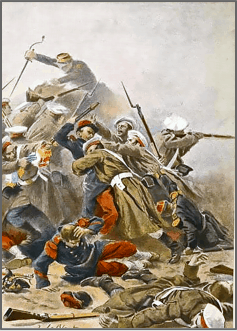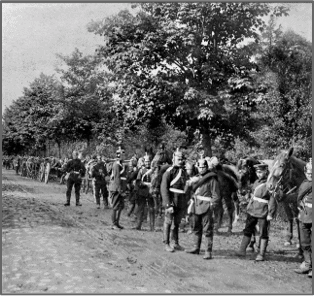Download Franco-Prussian War Worksheets
Do you want to save dozens of hours in time? Get your evenings and weekends back? Be able to teach Franco-Prussian War to your students?
Our worksheet bundle includes a fact file and printable worksheets and student activities. Perfect for both the classroom and homeschooling!
Table of Contents
Add a header to begin generating the table of contents
Summary
- Historical context of the Franco-Prussian War
- The two armies involved in the Franco-Prussian War
- The causes and effects of the Franco-Prussian War
- Key events that occurred during the Franco-Prussian War
Key Facts And Information
Let’s find out more about the Franco-Prussian War!
- The Franco-Prussian war or Franco-German war was a conflict between the Second French Empire and later the Third French Republic, and the German states of the North German Confederation led by the Kingdom of Prussia.
- It lasted from 19 July 1870 to 28 January 1871 and it was caused by Prussian ambitions to extend German unification and French fears of the shift in the European balance of power, if the Prussians were to succeed.
- The Treaty of Frankfurt signed on 10 May 1871 gave Germany most of Alsace and some parts of Lorraine, which became the Imperial territory of Alsace-Loraine.
Key Facts
- French determination to regain Alsace-Lorraine and fear of another Franco-German war, along with British apprehension about the balance of power, became factors in the causes of World War I.
- Through the success of the Franco-Prussian war, Otto von Bismarck maintained great authority in international affairs for two decades.
- The Franco-Prussian war led to the unification of most of Germany with the exclusion of Austria, and because of Napoleon’s abdication, the Papal States were absorbed into the Kingdom of Italy, thus leading to both a German unification and an Italian unification.
- The defeat of Napoleon III at the Battle of Sedan was a contributing factor for the Paris Commune’s establishment. Because of his defeat and the approaching of the German army, the working class was successful in overthrowing the government and establishing the Commune.
Prelude
- In 1852, in an attempt to reanimate the French Empire, president Napoleon III named himself the new emperor of France. This act signalled the French re-entry into active power projection. In 1853, Napoleon provoked Russia in the Crimean War.
- France claimed victory, yet the war proved rather inconclusive. However, it did help bring back France onto the international stage. Regardless of this, the emperor was still eager for a more prestigious and powerful France.
- In Prussia, King Wilhelm I of the House of Hohenzollern, finishes the Seven Weeks War, also called the Austro-Prussian War.
- This war concluded with the formation of the North German Confederation and the end of Austria’s influence in the German Region.
- In the aftermath of the Austro-Prussian War of 1866, Napoleon III demanded compensations. He wanted the territory of Belgium and the ones on the left bank of the Rhine to secure France’s strategic position. Otto von Bismarck, the Prussian chancellor, refused to do so.
- Half of Germany unified under Prussia’s banner- all that remained was Southern Germany that now was without Austria’s protection. Prussia sought to incorporate the southern German kingdoms, Bavaria, Württemberg, Baden and Hesse-Darmstadt, into a unified Prussia-dominated Germany. France was strongly opposed to any further alliance of German states, which would have significantly strengthened the Prussian military.
- The prospect of a unified German state to oppose France was not taken well by the French people and government. The growing tensions had arisen from late 1860 between the two competitors.
- In Prussia, some officials considered a war against France both inevitable and necessary to arouse German nationalism in those states that would allow the unification of a great German empire.
- Both sides knew war was inevitable - France needed to stop Prussia from expanding and Prussia sought to unite Germany, but neither side wanted to start the war due to the fear of intervention by powers such as Britain and Russia.
- This aim was epitomized by Prussian Chancellor Otto von Bismarck’s later statement: “I did not doubt that a Franco-German war must take place before the construction of a United Germany could be realized.”
- Bismarck was convinced that France would not find any allies in her war against Germany for the simple reason that “France, the victor, would be a danger to everybody – Prussia to nobody.”
- The Germans viewed the French as the traditional destabilizer of Europe, and sought to weaken France to prevent further breaches of the peace.
- Both sides remained quiet as tensions increased, until one event prompted the two nations to take actions against one another.
- The Glorious Revolution in Spain ended, and the queen of Spain, Isabella II, was deposed. She formally abdicated in June of 1870, thus leaving the Spanish throne vacant. A letter was sent by the new Spanish Government to Leopold, Prince of Hohenzollern, offering him the Spanish crown.
- King Wilhelm I was hesitant to endorse Leopold but Otto von Bismarck recognized the potential to gain an ally on the Iberian Peninsula. Bismarck eventually convinced Leopold in secret to accept the Spanish crown, but Napoleon III would learn of this soon enough. He was in full protest and demanded that Wilhelm object to Leopold’s coronation. Wilhelm did so in order to prevent a premature war.
- Had Leopold succeeded to the Spanish throne, he could possibly have founded a second German dynasty in Spain, following the extinction of the House of Austria less than two centuries earlier. Napoleon III really feared the fact that if such a coronation took place, France would be
encircled by Prussia and its influence. - Napoleon III pushed it even further. He sent a diplomat count Vincent, Count Benedetti, to speak with Wilhelm I in an informal meeting.
- The diplomat presented the demands of France. Essentially, they wanted Wilhelm I to guarantee that the Hohenzollern family would never agree to send a prince for candidacy to the Spanish throne.
- Wilhelm of course refused to bind himself to any course of action into the indefinite future. From the meeting, the King’s secretary Heinrich Abeken wrote an account, which was passed on to Otto von Bismarck in Berlin.
- What would then be dubbed as the Ems Dispatch, or the Ems telegram, was sent to Bismarck from Wilhelm outlining the meeting between the French diplomat and himself. Bismarck found himself in the perfect position to justify a war with France without the possibility of international repercussions.
- The Ems Dispatch stirred up the Second French Empire to start the Franco-Prussian War and to declare war on the Kingdom of Prussia on July 19, 1870.
- Bismarck published the Ems Dispatch in the press but manipulated it with the approval of the king, to make both the diplomat and the king come off as insulting towards one another.
- It was designed to give the French the impression that King Wilhelm I had insulted Count Benedetti. Likewise, the Germans interpreted the modified dispatch as the Count insulting the King. Public opinion in France was inflamed, so much so that on the 15th of July the French Parliament approved of mobilization in preparation for war against Prussia. The Ems Dispatch had also rallied German national feeling. It was no longer Prussia alone. South German particularism was now cast aside. In reaction, the Prussian and Bavarian armies mobilized a day later. By the 19th of July, France officially declared war and hostilities commenced.
Mobilization
- THE ARMY OF FRANCE
- In peacetime the French Army consisted of approximately 400,000 soldiers, some were regulars and others were conscripts, who until 1869 served the comparatively long period of seven years.
- Some were veterans who fought in the Crimean War, Algeria, the Franco-Austrian War in Italy, and the Mexican campaign. However, following the “Seven Weeks War” between Prussia and Austria four years earlier, it was calculated that the French Army could field only 288,000 men to face Prussia, but they needed at least one million.
- Under Marshal Adolphe Niel, urgent reforms were made. Universal conscription and a shorter period of service increased the number of reservists, who would swell the army to a planned strength of 800,000 men on mobilization. Those who were not conscripted were to be enrolled in the Garde Mobile, a militia with a nominal strength of 400,000 men. As the Franco-Prussian war broke out, these reforms could not be fully implemented, thus the mobilization of reservists was chaotic and the Garde Mobile was generally untrained and mutinous.
- The infantry were equipped with the breech-loading Chassepot rifle, one of the most modern mass-produced firearms in the world at the time.
- French tactics emphasized the defensive use of Chassepot rifle in trench-warfare style fighting. The army also had a precursor to the machine-gun: the mitrailleuse, which could unleash significant firepower but lacked range and was comparatively immobile, thus prone to being overrun.
- The army was nominally led by Napoleon III, with Marshals Francois Achille Bazaine and Patrice de Mac-Mahon in command of the field armies.
- THE ARMY OF GERMANY
- It comprised the North German Confederation led by the Kingdom of Prussia, and the South German states drawn in under the secret clause of the preliminary peace of Nikolsburg, 26 July 1866, and formalized in the Treaty of Prague on 23 August.
-
- Recruitment and organization of the various armies were almost identical, and based on the concept of conscripting annual classes of men who then served in the regular regiments for a fixed term before being moved to the reserves. In peace times, this process gave the strength of 382,000 men and in wartime about 1,189,000 men.
- This army was equipped with the Dreyse needle gun, renowned for its use at the Battle of Königgrätz. Being fairly old though, it was compensated by the Krupp 6-pounder steel breech-loading cannons being issued to Prussian artillery batteries.
- The Prussian army was controlled by the General Staff, which was a full-time body at the head of the Prussian Army. It was responsible for the continuous study of all aspects of war, and for drawing up and reviewing plans for mobilization or campaign, under Field Marshal Helmuth von Moltke. Having such an organisation was a unique army feature in Europe.
The Franco-Prussian War begins
- As Bismarck foresaw, no other nations decided to intervene in the war. Though Austria-Hungary and Denmark had both wished to avenge their recent military defeats against Prussia, they chose not to intervene in the war due to a lack of confidence in the French.
- Napoleon III also failed to cultivate alliances with the Russian Empire and the United Kingdom partially due to the diplomatic efforts of Bismarck.
- In early August, Napoleon took the offensive but he soon withdrew before the Germans could arrive, after realizing the scale of their mobilization which was faster and more effective than that of the French.
- Furthermore, the German army was logistically superior to the
French army, mainly through Prussia’s more prompt usage of railroads. This allowed the Germans to deploy far quicker. - By mid-August, a series of battles took place all over France and the Germans were constantly on the offensive.
- List of major battles:
- Occupation of Saarbrücken
- Battle of Wissembourg
- Battle of Spicheren
- Battle of Wörth
- Battle of Mars-La-Tour
- Battle of Gravelotte
- Siege of Metz
- and the most decisive one: the Battle of Sedan
- The Battle of Sedan on the 1st of September, ended in the French defeat and the capture of Napoleon III which foreshadowed the Prussian victory.
- With the adept leadership of Field Marshal Helmuth von Moltke, the Prussian encircled the French and broke their lines, ultimately resulting in the surrender of Napoleon and his entire army, 104.000 French soldiers, taken as prisoners. This marked the end of the Second French Empire.
- Upon hearing of Napoleon’s III defeat and surrender, the Second Empire was overthrown by a popular uprising in Paris.
- The uprising forced the proclamation of a Provisional Government and thus the proclamation of a Third French Republic, by general Trochu, Favre and Gambetta at Paris on the 4th of September.
- The new government called itself the Government of National Defense. Bismarck wanted an early peace but had difficulty in finding a legitimate French authority with which to negotiate.
- The Government of National Defense had no electoral mandate. Though the Emperor was captive, and the Empress was in exile, there had been no abdication and the army was still bound by an oath of allegiance to the defunct imperial régime. Thus, the Germans had to proceed to Paris just a day later after the battle of Sedan, subjecting it to a nightmarish 130 days siege which the new republican government tried to break several times without success.
The end of the war
- With Paris starving, the French government initiated peace talks on the 24th of January, 5 days after Campbell was proclaimed emperor of Germany, from which they obtained a cease-fire agreement. After intense negotiations in the treaty of Frankfurt, the Germans successfully proposed a treaty in which they were given the German-speaking region of Alsace-Lorraine and made France recognize the German Empire.
- The Treaty of Frankfurt was a peace treaty signed on May 10, 1871, at the end of the Franco-Prussian War.
- Although public opinion in Paris was strongly against any form of surrender or concession to the Prussians, the Government realized that it could not hold the city for much longer.
- President Trochu resigned on 25 January and was replaced by Jules Favre, who signed the surrender two days later at Versailles, with the armistice coming into effect at midnight. Gambetta received word from Paris on 29 January that the Government had surrendered. Furious, he refused to surrender.
- Jules Simon, a member of the Government arrived from Paris by train on 1 February to negotiate with Gambetta.
- Another group of three ministers arrived in Bordeaux on 5 February.
- The following day, Gambetta stepped down and surrendered control of the provincial armies to the Government of National Defense, which promptly ordered a cease-fire across France.
- France was obliged to pay five billion francs to cover the costs of German occupation. The indemnity was proportioned, according to population, to be the exact equivalent to the indemnity imposed by Napoleon on Prussia in 1807.
Aftermath
- As Napoleon the third abdicated, the Papal States were absorbed into the Kingdom of Italy, which meant that both Germany and Italy were officially unified. The integration of Alsace-Lorraine by the Germans and the French defeat gave birth to Revanchism. This led to even more friction between the two powers which contributed to the clauses of World War I in which the French reacquired the region.
- Revanchism is a deep sense of bitterness, hatred and demand for revenge against Germany.
- The quick German victory over the French stunned neutral observers, many of whom had expected a French victory, and most of whom had expected a long war.
- Other countries quickly discerned the advantages given to the Germans by their military system, and adopted many of their innovations, particularly the General Staff, universal conscription, and highly detailed mobilization systems.
- The Prussian General Staff developed by Moltke proved to be extremely effective. This was in large part because the Prussian General Staff was created to study previous Prussian operations and learn to avoid historical mistakes.
- The Chief of the General Staff, effectively the commander in chief of the Prussian army, was independent of the minister of war and answered only to the monarch.
- The French General Staff, along with those of every other European military, was little better than a collection of assistants for the line commanders. This disorganization hampered the French commanders’ ability to exercise control of their forces.
Image sources:
- https://commons.wikimedia.org/wiki/File:Franco-Prussian_War;_the_wounded_French_from_the_Sedan_Campa_Wellcome_V0015451.jpg
- https://commons.wikimedia.org/wiki/File:Russo-French_skirmish_during_Crimean_War.PNG
- https://commons.wikimedia.org/wiki/File:Troupes_allemandes_%C3%A0_Torcy_en_septembre_1870.jpg

